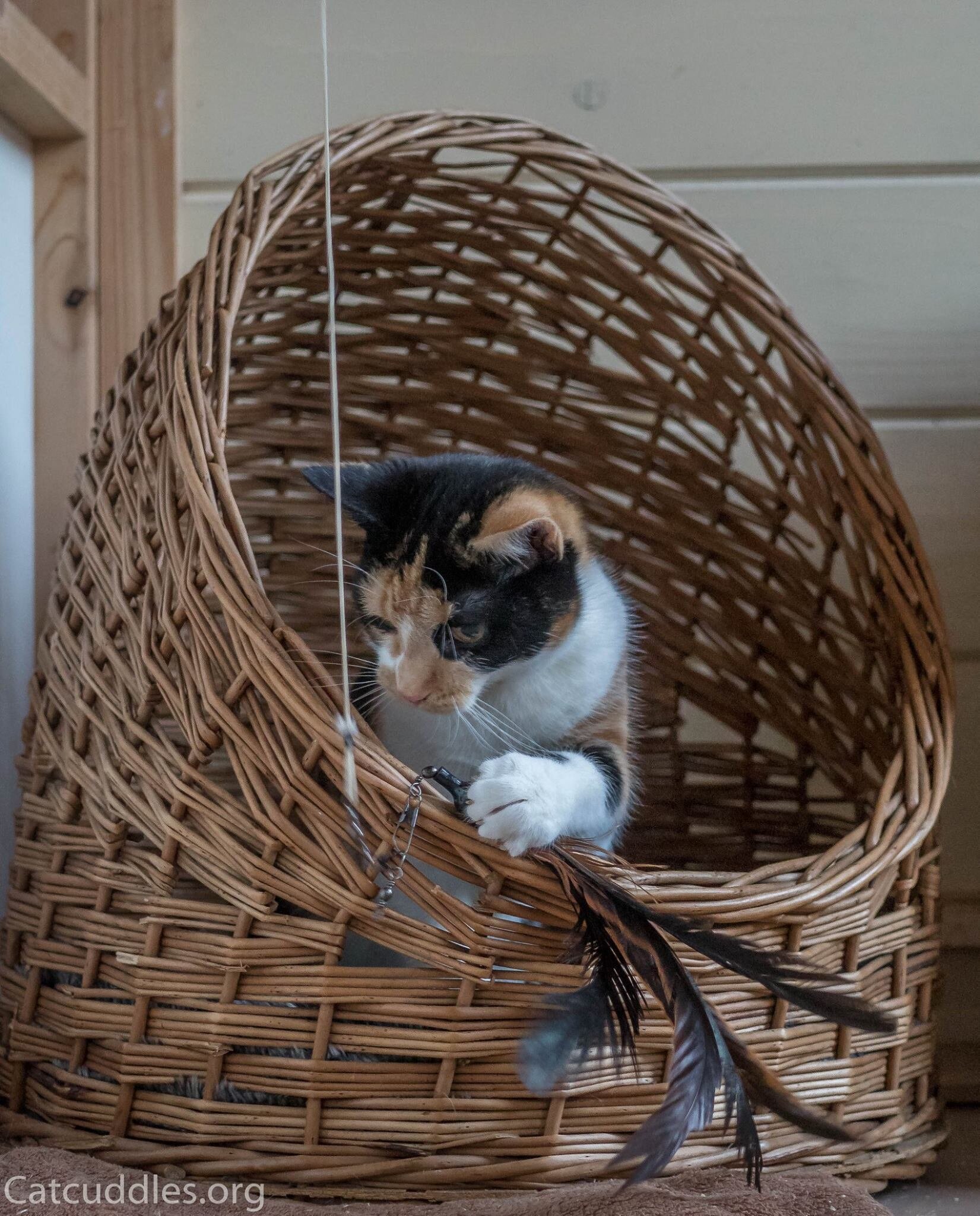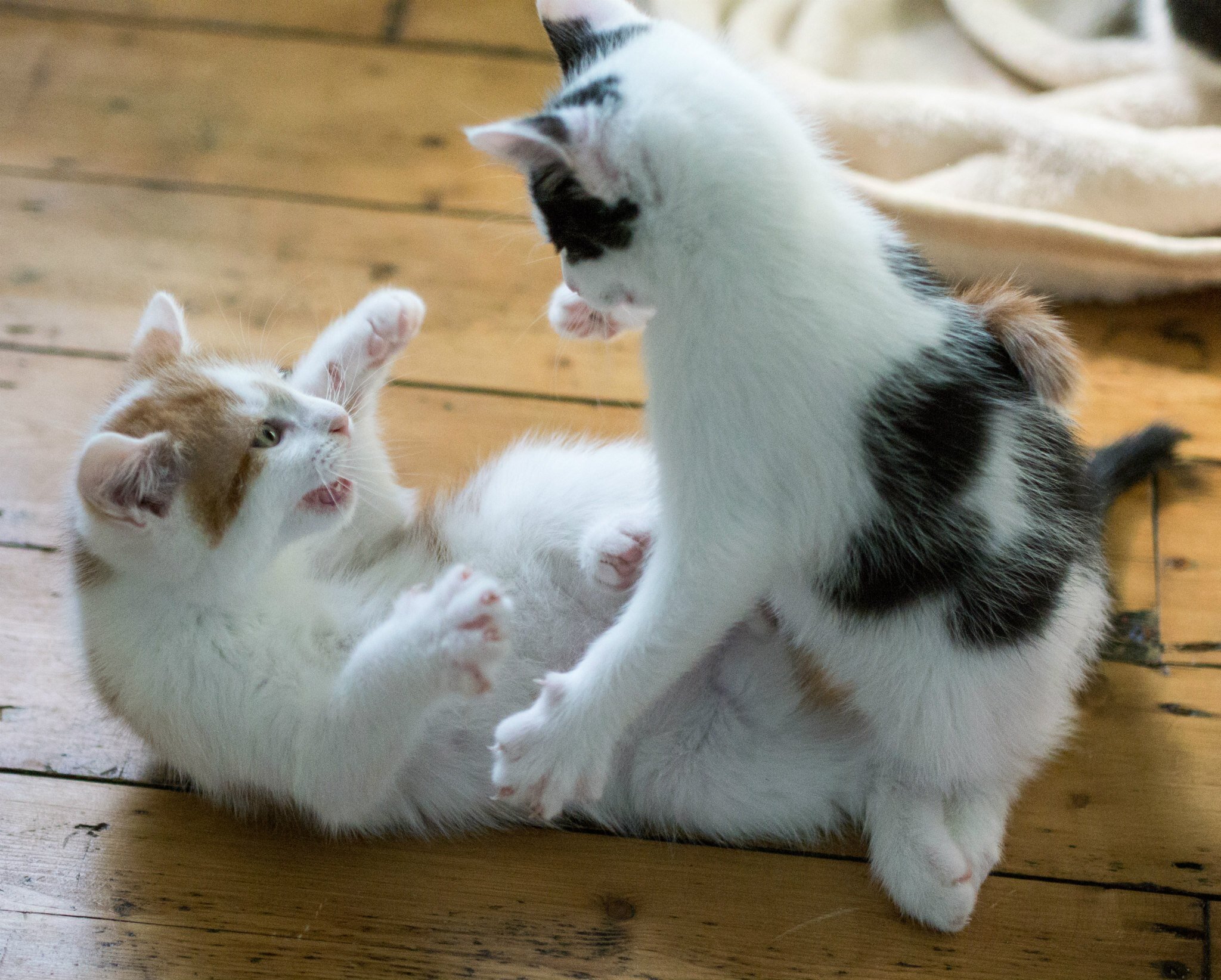Having a cat can benefit a child in a multitude of ways. Cats offer comfort and companionship whilst also helping to instil children with a sense of compassion and respect for animals, and for kids who struggle with social anxiety or with verbal communication in particular, this relationship can be life-changing.
However, young children may be unable to read the body language of cats, and in their excitement, frighten or overwhelm them, leading to more negative interactions, or to cats becoming increasingly unhappy in the home environment.
In order to maintain a safe and harmonious home for both cats and children, it’s important to take steps to help children understand cat behaviour, and to plan from the offset for new arrivals - whether they are of the human or feline variety.
Here are our top tips for having kids and cats together in the home, including some from Catcuddles adopters.
Plan ahead to avoid the need for rehoming later on.
If you plan to have children in the next few years, then please take this into consideration when you bring a new cat into your home. Will you still be able to give your cat the time and attention he or she needs when children arrive? Does your new cat have the right temperament for living with children? If you plan on getting a kitten, then you may not know whether he or she is a good fit for family life until the kitten is older - therefore adopting an adult cat whose temperament is already known may be a better option. A cat can live for up to twenty years, so you must consider all of these things before bringing one home. If you are not prepared to care for a feline throughout any major life changes that may occur in the next few years, then this may not be the right time to get a cat. Sadly, one of the most common reasons for surrendering a cat that we see at Catcuddles is the arrival of a new baby. A little forethought can sometimes help to prevent this heartbreaking decision.
Prepare your cat for the arrival of a new baby.
The arrival of a new baby means a lot of changes in a cat’s life; new smells, new sounds, and humans with a lot less time to spare. Cats are creatures of routine, so rather than simply springing a new baby on him or her, prepare your cat gradually. You can ask friends or family with babies to visit your home, to help familiarise your cat with the sounds and smells associated with a baby. You can also play recordings of babies crying on YouTube to help acclimatize them to this noise. You don’t need to allow your cat to climb into prams or cots if you’d prefer they didn’t, but you can allow them to sniff and investigate these new items when they first enter the home. When the baby arrives, you can also allow them to smell blankets or other items that have been near the baby before you directly introduce them.
Maintain routines where possible, or introduce new routines gradually.
Consistency is key to keeping a cat’s stress levels low, so do your best to maintain your cat’s normal routines relating to feeding, going outside, sleeping, and getting attention - although we understand this can be a struggle with a new baby. If adjustments need to be made, try to begin implementing these gradually, or if possible, a few weeks before the baby comes home.
Teach kids how to properly interact with cats.
If you already have kids and are hoping to bring a cat into your home, then it’s imperative that you teach your children how to interact with cats safely and respectfully even before the cat’s arrival - for example, teach your children that they should speak in a low, calm voice and offer their hand for a cat to sniff prior to beginning to stroke gently. They need to know that shouting, chasing, and pulling tails isn’t appropriate, that many cats do not like to be picked up, and that cats often need their own space or to approach on their own terms. These lessons may be more difficult to impart to younger children, so they will need to be supervised closely, and also be reminded gently but frequently of the ground rules.
Understand that not all cats like to be picked up.
No matter how much we want to cuddle them, some cats will simply never enjoy being picked up, and your children need to be made to understand this too. If your cat is tolerant of being handled, then you can teach your child the correct and safest way to hold them, so that your cat isn’t uncomfortable or at risk of being dropped. Even tolerant cats won’t want to be picked up all the time, however, and kids need to be aware of this and keep handling to a minimum, and that in general, allowing a cat to approach on his or her own terms is the best way to interact.
Learn to spot warning signals in your cat’s body language.
Even the most tolerant and family-friendly cat will sometimes need some space from excitable children. If your cat is uncomfortable or anxious, then this will be apparent in his or her body language. Learning to recognise signs that your cat is feeling overwhelmed during interactions with children is key in preventing situations from escalating to the point of biting or scratching. Look out for signs of irritation such as ears held flat against the skull, frantic tail flicking, dilated pupils or widened eyes, growling, hissing, crouching, or cats attempting to move away.
Make first impressions positive.
A negative first impression can have a lasting impact on a cat’s relationship with a child, and can be hard to erase. Preparation is key - make the first meeting as positive as possible by ensuring that children are aware of how to properly interact with cats before the first meeting occurs. If introducing a cat to a new baby, set aside some quiet time to do this, perhaps when the baby is asleep, allowing your cat to sniff the new arrival under close supervision. You can also help reinforce a cat’s positive association with a baby by offering them treats during and after the first meeting.
Supervise!
It’s impossible to supervise your children 24-hours a day, but monitoring interactions between your child and cat as much as possible is imperative in the early stages of their relationship. This is not only to keep both parties safe, but also ensures that negative precedents aren’t set that will be difficult to undo later on.
A Case Study - Rocky
“Rocky had been with us for nearly two years when our eldest was born. Before she arrived, we got the baby equipment out so that he could sniff it and get used to it being around - giving cats the chance to get used to new smells that a baby would bring helps prepare them for the new arrival!
When we bought her home, we placed her in her basket and put her on the floor so that he could see his new sister... he gave her a sniff and then promptly sat next to her as if to say, ‘she’s okay'.
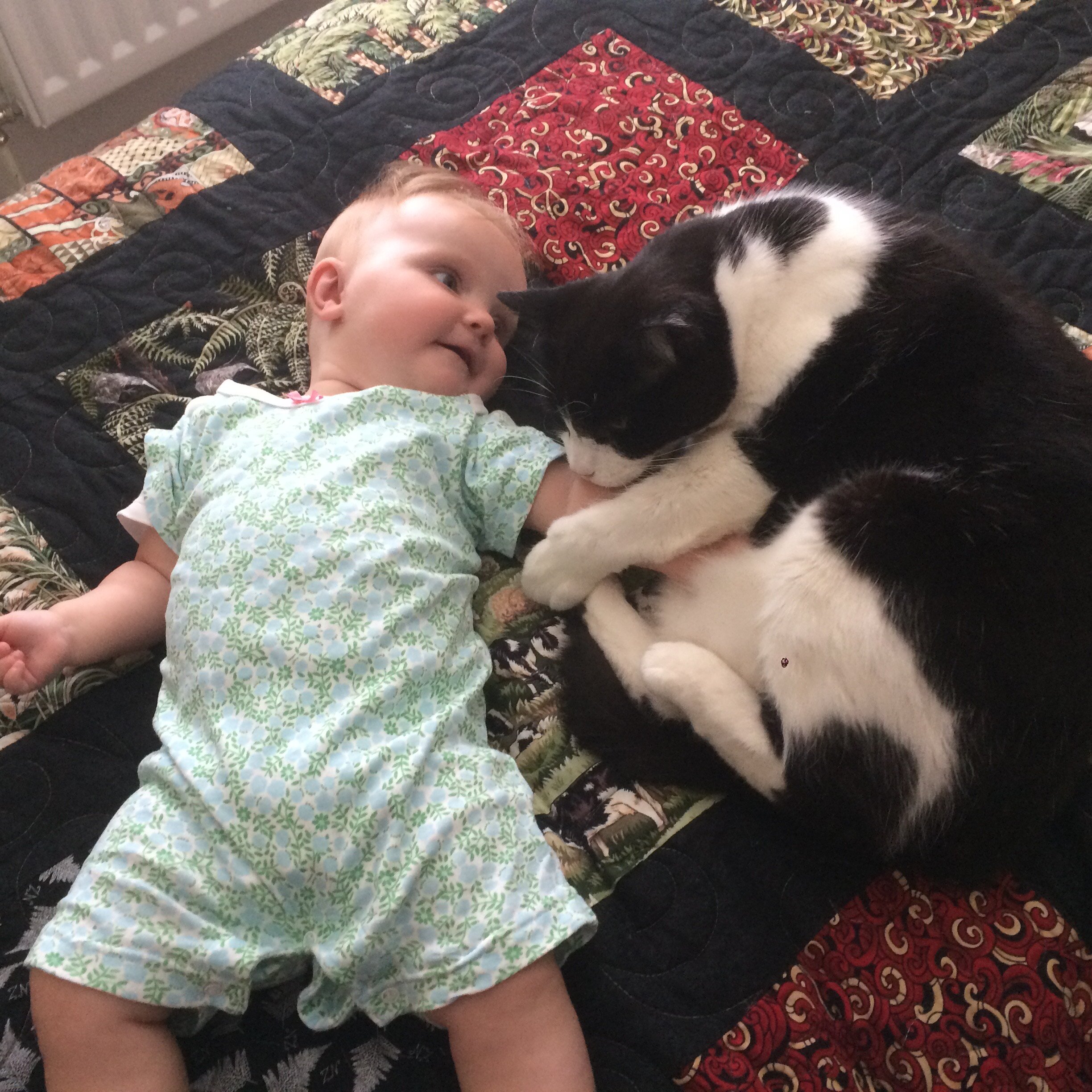
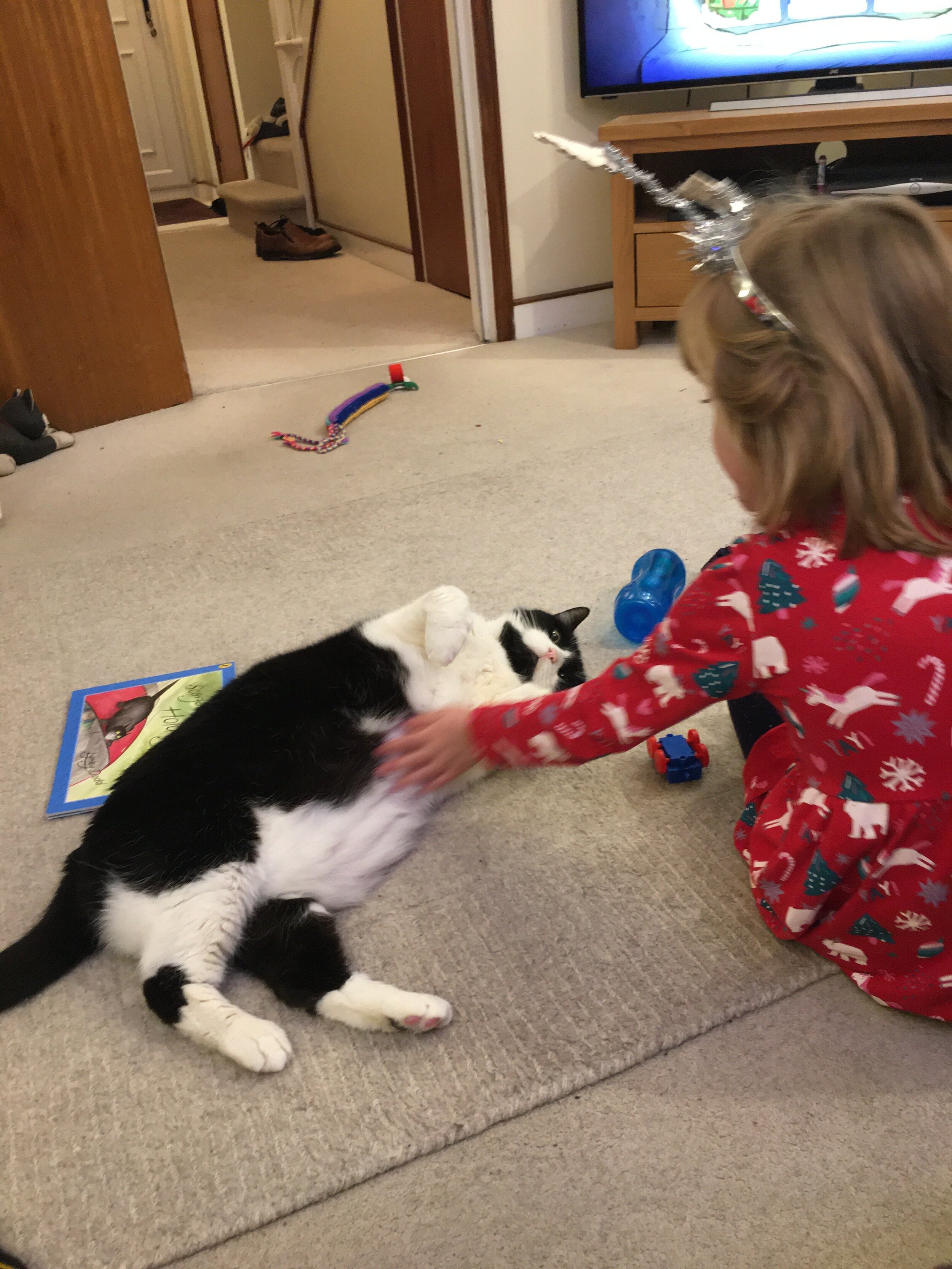
As she got bigger and became more active, she was on the floor at his level, and he began to sit beside her more while she would rub his belly. We never told him ‘no’ if he went near her and we left her bedroom door open so that he could wander in and out - in our experience, making things off-limits only encourages cats to go where they aren’t supposed to - we gave him an all-access pass to the house!
We kept his routine as it was and still made time to give him a bit of fuss, and he coped brilliantly with two children arriving. He is an indoor cat - and when he has had enough of the noise or any unwanted attention, he takes himself off for a bit of a timeout but likes to involve himself when the children are playing as well.
Even Rocky being an indoor cat and having a litter box inside hasn’t given us any issues, as we make sure the box is changed often and the children have been taught not to touch it!
The bond between a cat and his or her small humans can be amazing if a bit of patience and time is invested. It’s so worth it seeing them play together and it also teaches children care, compassion, and responsibility.”
- Brigitte, Catcuddles adopter.
More top tips:
Adopt a cat with the right temperament.
One of the benefits of adopting from a rehoming centre is that the centre can match you with an adult cat who has previously lived happily with children. This might mean waiting a little longer and contacting more than one rehoming charity, but there are many cats with the perfect laidback temperament for family life who are in need of rehoming, and a reputable organisation should allow meetings between child and cat prior to adoption to ensure a good fit. The cats most suitable for sharing space with children tend to be confident, outgoing and well socialised. Shy or sensitive cats, particularly those prone to cystitis or other stress-related conditions, may not be ideal.
Consider carefully whether a kitten is a good fit.
The idea of having a cat and child grow up together can be very appealing, and children themselves are often keen on the idea of welcoming a cute kitten to the home. However, you need to be aware that a kitten’s temperament may change as they grow older, and that kittens require huge amounts of time and attention, something that may be difficult to provide in a busy family household. In particular, kittens may not be well suited to children under five, as they don’t have the wisdom of adult cats, and may not know how to avoid unwanted behaviour from a toddler without conflict. Bringing an overlooked older cat into your home may also be a great opportunity to teach children about compassion, and that cuteness isn’t everything.
Give your cat safe spaces to escape to.
Even cats who are happy to share space with children will need a little ‘downtime’ away from their rambunctious housemates, and your cat should ideally have access to at least one location in the home where the children don’t often venture, or that’s off-limits altogether. Many people find ‘catifying’ their homes with shelves or platforms is a great way to provide cats with their own space, and cat trees and houses placed up high are also an option. Cats without any child-free zone in the home to retreat to may end up spending more time outside.
Don’t exclude your cat from family life.
Although it’s understandable that new parents may be worried about introducing their cat to their baby, excluding the cat completely will not be conducive to developing a good relationship between cat and child in the long-run. It’s important to include the cat in the process of bringing a new baby home and gradually acclimatise them to the baby’s presence as much as possible. Likewise, if you are struggling to maintain a peaceful co-existence between cats and children in your home, then shutting your cat out of family life isn’t the best solution and in many cases, will worsen negative behaviour, as stress is often at the root of bad habits. If you are experiencing difficulty, then seek advice from organisations that specialise in cats such as Catcuddles, from a cat behaviourist, or from your vet.
A Case study - Miley & Freddie

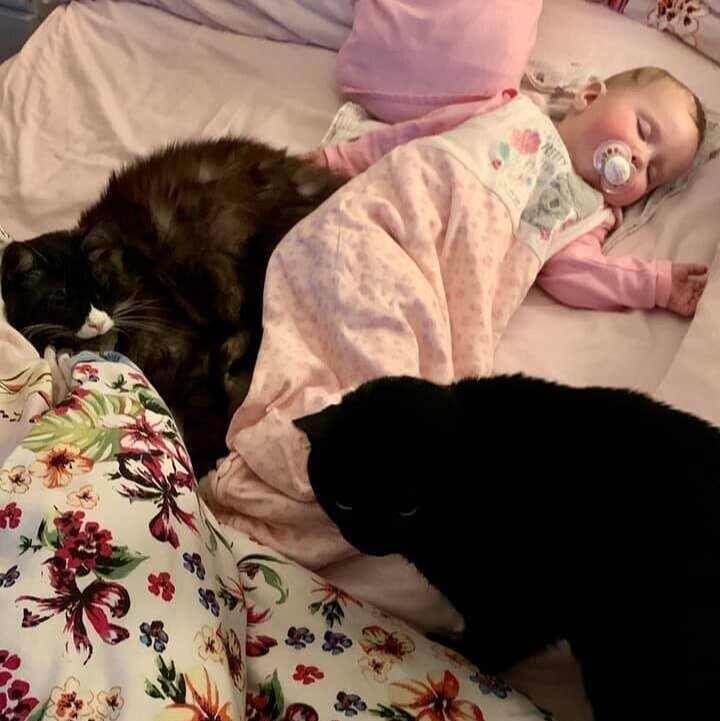
“When I fell pregnant I was shocked at the number of people who asked, “What will you do about the cats?” - as though you couldn’t possibly have cats and children together. Honestly, I was a little nervous about how the cats would react to a small human taking away all the attention, but they were hardly bothered, and left the baby alone until she started the crawling stage and began to show interest in them.
Now she is obsessed with the cats and “Freddie” was one of her first clearly spoken words. We have taught our daughter how to be gentle and affectionate towards our cats, and they are gentle with her in return. Growing up with pets helps teach children how to be kind and patient. The cats are very protective of Chloe and love to sleep on a chair in her bedroom or outside her door when she is in bed.”
- Natasha, Catcuddles adopter.
More top tips:
Be consistent.
If you’ve decided that you don’t want your cat in your baby’s room at night, or to climb into items like cribs and prams, then make this a rule from the offset - even before the baby arrives - and be consistent about it. Letting the cat sleep in a crib when it is empty, but expecting the cat to know that it is off-limits when the baby is asleep in it, sends mixed messages. The same applies to children - set ground rules early on and stick to them, like not disturbing your cat when he or she is sleeping or eating.
Don’t expect your child to be solely responsible for your cat’s care.
Having a cat can help instill children with a sense of responsibility, however, expecting your child to be your cat’s primary care-giver is unrealistic and often not in the cat’s best interests. No cat should go without proper care because a child is distracted or has lost interest, and cats sometimes get rehomed because a child has failed to look after them as promised. Children can easily miss signs of distress or ill health that will be obvious to an adult, and cannot be expected to be on top of issues like worming and flea treatments and regular veterinary check-ups. For these reasons, we recommend that you assign your children some, but not all, tasks related to the care of a cat in the family home.
If possible, check for allergies in children BEFORE you bring a new cat into the home.
Childhood allergies are common, and their sudden appearance is a recurrent reason for cats being rehomed. Allergies tend to flare up in response to the dander that a cat sheds, and the amount of dander produced varies from feline to feline. Therefore, just because your child isn’t allergic to a friend’s cat, doesn’t mean that they won’t be allergic to another cat. Ideally, your child needs to interact with a new cat for prolonged periods prior to you permanently welcoming him or her into your home. This is another benefit of adopting from a rehoming centre, as you are not only able to meet the cat prior to adoption, but you will also often have full ‘back up’ from the rehoming organisation if something goes wrong. It’s important to note that there is no such thing as a truly hypo-allergenic cat; just some breeds that produce less dander than others. Even these can still result in allergies.
Empathy is key.
Last but not least, it’s crucial to teach children to have empathy for any cat that shares their home, making them aware that he or she is a living thing capable of experiencing fear and pain. Your child should understand that they are not allowed to pull a cat’s tail not simply because it is against the rules of your house, but because it is unkind and will cause the cat suffering. This is a lesson that they can carry with them in all their interactions, not only with animals, but with people, too.
A Case Study - Giles & Dexter
“I was really worried that my cats, Dexter and Giles, would be stressed and feel displaced by the arrival of our first child. I thought it was important to ensure that their world and routine didn’t change. I carried on feeding them as usual and even with the chaos of newborns and toddlers, I always give them some private cuddle time. It never feels like a chore. That time is how I recharge too.

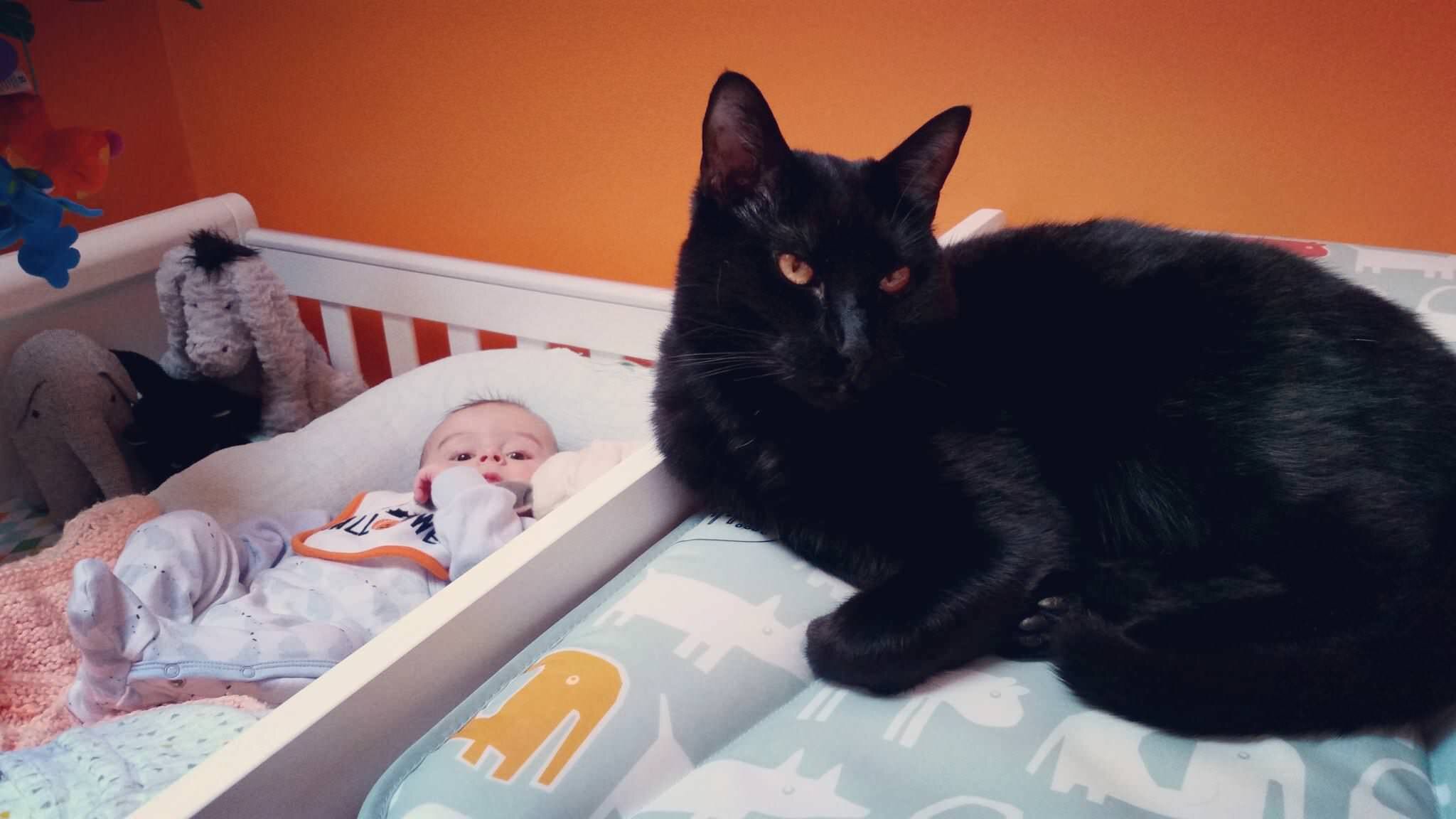

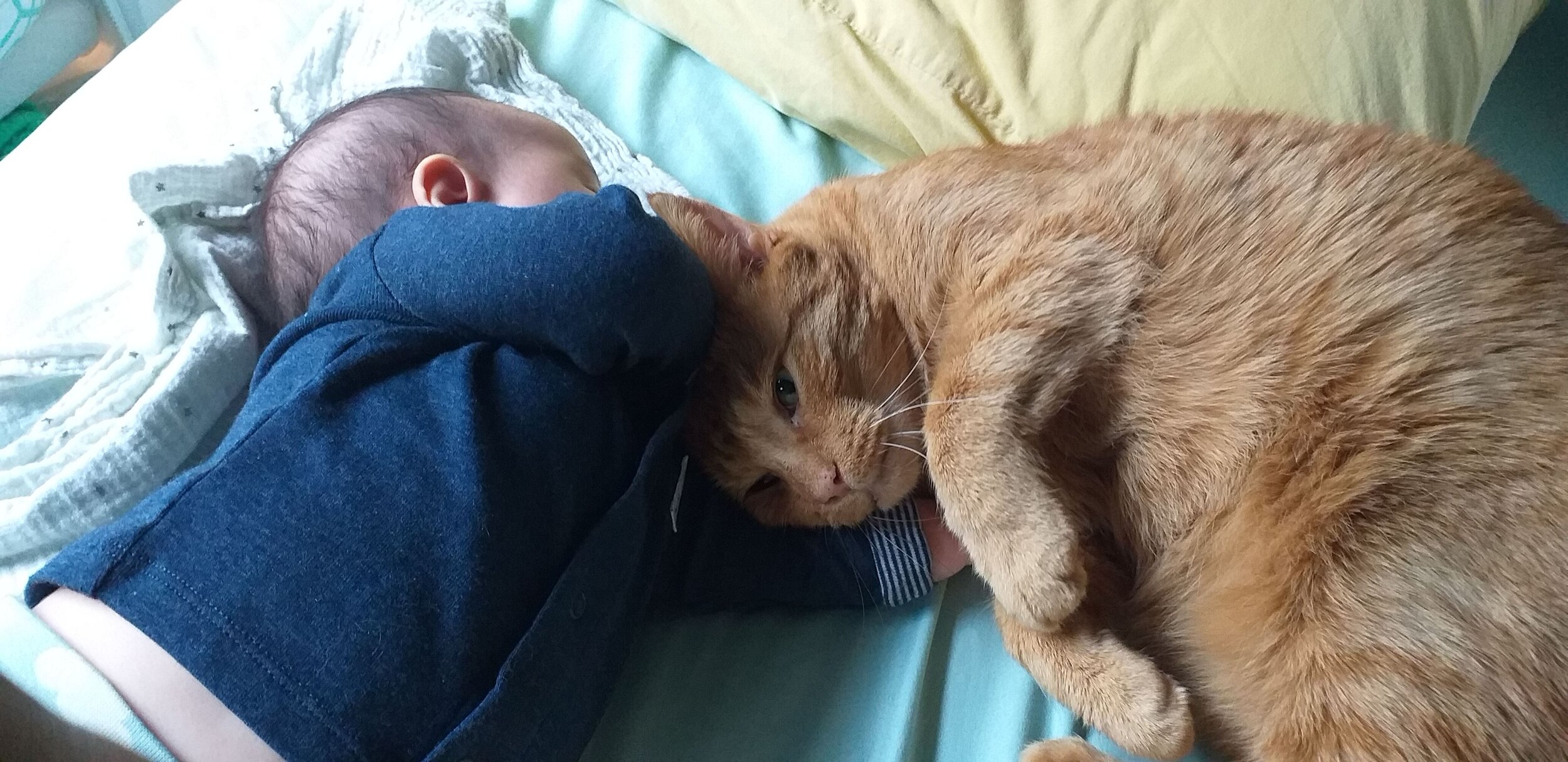
While I was pregnant, we let the cats explore all the baby kit and we didn’t keep them out of the nursery. They enjoyed jumping in and out of the cot bed and slept on the buggy. I never shooed them away or made them feel that parts of their house were off-limits.
When we came home with each baby, we waited for the cats to come up and sniff the new arrival. Those encounters are some of the more precious memories I have. Whenever my first newborn screamed, Dexter would barrel into the room and look at me as if to say, ‘WHAT HAVE YOU DONE TO THE BABY?’ It felt very protective of the baby! I found it amusing and strangely comforting. Giles was my constant companion during breastfeeding. He was there with me every feed and purring for cuddles. Those nights could be very long and lonely. I was deeply grateful for Giles’ support. It wasn’t always easy to stroke him and feed the baby simultaneously, but I enjoyed the company and thought it was the least Giles deserved for being there for me!
The challenges now with very active little boys are making sure the cats have get-away space—we put in wall shelves for them to jump on—and that the kids have an awareness of their effect on the cats. The cats surprise me by napping in the lounge when play is in full swing. I love it that they feel that comfortable.”
- Farnaz, Catcuddles adopter.
Common Worries About Babies and Cats
Do cats smother babies by sleeping on them?
This is something of an old wives' tale but nonetheless, it is a commonly held belief. It is the theory that cats, attracted to the smell of milk emanating from a baby, may sleep on infants in their prams or cribs, obstructing their breathing. Some even believe that cats deliberately ‘suck the breath’ from babies’ mouths out of jealousy. Whilst the latter is quite obviously absurd, it is not technically impossible for a baby’s breathing to be obstructed by any object that puts pressure on their chest or covers their airways. Reports of this happening as the result of cats, however, are very rare, and tend to be historic, dating back to a time when the causes of infant mortality were not well understood. In these historic cases, deaths caused by SIDS were most likely explained by the presence of a cat in the baby’s room due to the lack of any other explanation, and because of the association between cats and witchcraft. In modern times, cases of smothering attributed to cats are equally rare and are often very disputed, with the cat not conclusively identified as the cause of a baby’s unfortunate passing. It is, therefore, very, very unlikely that your cat will pose a risk to your baby in this way. If you wish to restrict your cat’s access to your baby’s crib or pram, it’s best to set this precedent early on, before the baby’s arrival.
Toxoplasmosis and Pregnancy
Toxoplasmosis is an infectious disease caused by the parasite toxoplasma gondii. It is not normally serious and produces no symptoms in the majority of people, however, it poses a greater risk to immunosuppressed people or to pregnant women, who can pass the infection to their unborn baby, leading to a number of issues. Toxoplasmosis can be transmitted through soil, through undercooked meat, eggs, unpasteurized milk, and through exposure to the feces of infected animals. Cats are among the species that can transmit the parasite through their feces, therefore pregnant women or those with weaker immune systems may want to take extra precautions around cat litter trays. They should be cleaned very regularly as the parasite only becomes infectious after being in the environment for 24-hours, and ideally by another member of the household. Cats with long hair around their back end should also be groomed regularly. Although Toxoplasmosis is asymptomatic in most felines, steps should always be taken to ensure that all cats in the home have a clean bill of health and are regularly being treated for all parasites.
Cats that hunt for wild prey may be more at risk of infection from Toxoplasmosis, or those fed on a raw diet. You can’t catch the disease from casual contact with an infected cat, such as stroking or touching.


